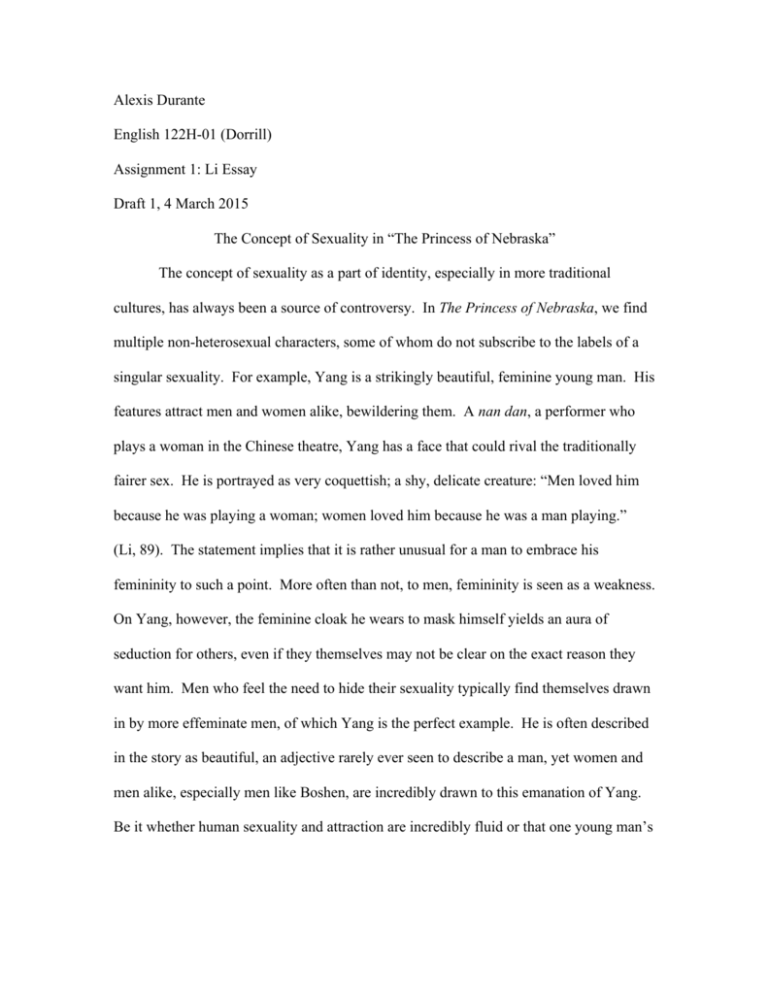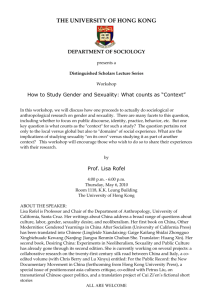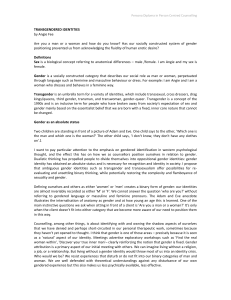The Concept of Sexuality by Alexis Durante
advertisement

Alexis Durante English 122H-01 (Dorrill) Assignment 1: Li Essay Draft 1, 4 March 2015 The Concept of Sexuality in “The Princess of Nebraska” The concept of sexuality as a part of identity, especially in more traditional cultures, has always been a source of controversy. In The Princess of Nebraska, we find multiple non-heterosexual characters, some of whom do not subscribe to the labels of a singular sexuality. For example, Yang is a strikingly beautiful, feminine young man. His features attract men and women alike, bewildering them. A nan dan, a performer who plays a woman in the Chinese theatre, Yang has a face that could rival the traditionally fairer sex. He is portrayed as very coquettish; a shy, delicate creature: “Men loved him because he was playing a woman; women loved him because he was a man playing.” (Li, 89). The statement implies that it is rather unusual for a man to embrace his femininity to such a point. More often than not, to men, femininity is seen as a weakness. On Yang, however, the feminine cloak he wears to mask himself yields an aura of seduction for others, even if they themselves may not be clear on the exact reason they want him. Men who feel the need to hide their sexuality typically find themselves drawn in by more effeminate men, of which Yang is the perfect example. He is often described in the story as beautiful, an adjective rarely ever seen to describe a man, yet women and men alike, especially men like Boshen, are incredibly drawn to this emanation of Yang. Be it whether human sexuality and attraction are incredibly fluid or that one young man’s charm is just enigmatic enough to enrapture all genders, The Princess of Nebraska plays with gender and sexuality in a new, thought-provoking light. In this story, Li does not portray any character’s sexuality very rigidly. While Yang is very clear in his attraction to men in his long-term relationship with Boshen, he also expresses his keen attraction to Sasha. Though she is portrayed as the seductress in the situation, the one dropping hints to him that she is very much interested, Yang quickly picks up the hints and reciprocates the desire. There are so many stories where a male broadly pursues a shy female, yet in Nebraska, Sasha makes her interest in him known, breaking personal space and initiating action, and Yang is always rather coy, very reticent. This says a great deal about the characters’ personalities as well. When Sasha is asked if her name is Mongolian, she answers: “It’s Russian, a name of my mom’s favorite heroine in a Soviet war novel,” (Li, 85). It reflects boldness and strength, and we see as much through her attitude toward sexuality and seduction in the story. Yang, named after the masculine element of nature, is one half of a whole: the masculine and feminine, the sun and the moon, night and day. Both men and women find his features stunning and attractive, being a man with such feminine traits. In Sex and Gender, Beyond the Binaries, authors Joy Johnson and Robin Repta quote gender theorist Judith Butler on how in a heteronormative society, this is often strange: “heterosexual desire plays an important role in constructing masculinity and femininity as opposing genders. She argues that within dominant heterosexuality, the object of masculine desire is inherently feminine, while the object of feminine desire is inherently masculine.” (Johnson, Repta, 14). Yang is a complex character, whose fluid sexuality is a reference to the way that he himself lives in fluidity. He lives a life of intricacy, playing a female in the theatre and a man at night, and by loving a man by day and selling himself by night. His character is one of the most fascinating and dynamic in the story for these reasons.










